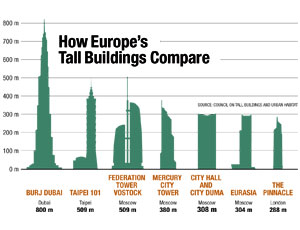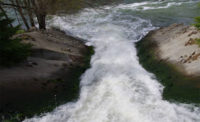Moscow’s Federation Tower is well on the way to becoming Europe’s tallest building at 365 meters, with one of the world’s loftiest concrete frames. With its accompanying 509-m-tall observation tower, the skyscraper is on “super fast track,” a schedule that sometimes has left the building’s Chinese contractor struggling to keep up with a design that keeps evolving.

As one of Russia’s first modern skyscrapers, the two-building Federation Tower development leans heavily on western expertise in design, management and materials. But construction has been entrusted to contractors from China and Turkey, with not always comfortable results.
“Fast track” to the development’s American and European designers translates to “design that changes all the time,” says Yan Bo, chief engineer with the main contractor, China State Construction Engineering Corp., Beijing. Consequently, the project is likely to open two years later than it proclaims on the billboard outside, say project sources.
The cultural muddle cuts both ways. “There is not even a schedule” to erect the mostly concrete tower’s immense steelwork outriggers, says Utku Baris Bicak, quality and safety manager with Turner International, construction management consultant for owner Mirax Group.
Watching Chinese ironworkers crawling all over an outrigger more than 60 floors up, he adds, “They promised to finish it in 85 days,” but gave no specifics.
But when the site is on full production, progress pleases Glenn Collins, Turner’s Russia country manager. “We’ve achieved in winter conditions a nine-day cycle on floors, which is excellent,” he says.
Federation Tower comprises two structurally independent skyscrapers rising from a shared podium. The spire of an observation tower between them soars 509 m above ground.
Framed in reinforced concrete until 325 m, the taller building is topped by a 45-m-tall steel frame and incorporates outriggers. It is about three-quarters up, with its structure and curtain wall due for completion late next year. The shorter, 242.4-m-tall building, with no outriggers, is already occupied.
Both buildings have footprints with three curved sides, roughly 60 m long on the taller. Its three sides are vertical until level 26, then two slope inward.
Two bridges between the buildings and an observation platform projecting from the taller one near its top stabilize the 8-m-dia observation tower. The tower is in concrete for the first 220 m and in steelwork for the next 200 m. A pipe-like spire, with two tuned pendulum dampers, will rise to 509 m.
Federation Tower has a four-hour fire rating and can lose a major column, beam or floor bay without a progressive collapse, according to the structural designer, New York City-based Thornton Tomasetti, Inc. (TT).
Mirax launched an international design competition in 2003 for what will be Moscow City’s landmark building, says Matthias Lassen, lead project architect with NPS Tchoban Voss GbR Architekten BDA, Berlin. His firm with German-based Prof. Peter Schweger, ASP Architekten won the contract.
TT got its design contract almost by accident, while principal Leonid Zborovsky was in Moscow four years ago. Believing the contract had been let, he was delighted to learn it was still up for grabs when he met Sergei Polonsky, Mirax’s cofounder and chairman.
“When I walked into his office [Polonsky] was very happy I spoke Russian,” says Zborovsky. After a long night reviewing project drawings, Zborovsky met the developer again and got the job, after suggesting changes.
Zborovsky didn’t like the original hexagonal cores. Because of the schedule, he could not alter the smaller building. But in the taller, “we completely changed the shape...to a more classical high-rise core,” he says. The core’s new trapezoidal footprint had more elevator space and eased outrigger geometry, he adds.
The struggle to refine the design went further. Instead of having steel outriggers, Polonsky wanted concrete...





Post a comment to this article
Report Abusive Comment